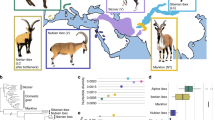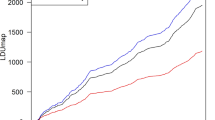Abstract
Non-African populations have experienced size reductions in the time since their split from West Africans, leading to the hypothesis that natural selection to remove weakly deleterious mutations has been less effective in the history of non-Africans. To test this hypothesis, we measured the per-genome accumulation of nonsynonymous substitutions across diverse pairs of populations. We find no evidence for a higher load of deleterious mutations in non-Africans. However, we detect significant differences among more divergent populations, as archaic Denisovans have accumulated nonsynonymous mutations faster than either modern humans or Neanderthals. To reconcile these findings with patterns that have been interpreted as evidence of the less effective removal of deleterious mutations in non-Africans than in West Africans, we use simulations to show that the observed patterns are not likely to reflect changes in the effectiveness of selection after the populations split but are instead likely to be driven by other population genetic factors.
This is a preview of subscription content, access via your institution
Access options
Subscribe to this journal
Receive 12 print issues and online access
$209.00 per year
only $17.42 per issue
Buy this article
- Purchase on Springer Link
- Instant access to full article PDF
Prices may be subject to local taxes which are calculated during checkout



Similar content being viewed by others
References
Charlesworth, B. Fundamental concepts in genetics: effective population size and patterns of molecular evolution and variation. Nat. Rev. Genet. 10, 195–205 (2009).
Li, H. & Durbin, R. Inference of human population history from individual whole-genome sequences. Nature 475, 493–496 (2011).
Keinan, A., Mullikin, J.C., Patterson, N. & Reich, D. Measurement of the human allele frequency spectrum demonstrates greater genetic drift in East Asians than in Europeans. Nat. Genet. 39, 1251–1255 (2007).
Gronau, I., Hubisz, M.J., Gulko, B., Danko, C.G. & Siepel, A. Bayesian inference of ancient human demography from individual genome sequences. Nat. Genet. 43, 1031–1034 (2011).
Lohmueller, K.E. et al. Proportionally more deleterious genetic variation in European than in African populations. Nature 451, 994–997 (2008).
Tennessen, J.A. et al. Evolution and functional impact of rare coding variation from deep sequencing of human exomes. Science 337, 64–69 (2012).
Fu, W. et al. Analysis of 6,515 exomes reveals the recent origin of most human protein-coding variants. Nature 493, 216–220 (2013).
Casals, F. et al. Whole-exome sequencing reveals a rapid change in the frequency of rare functional variants in a founding population of humans. PLoS Genet. 9, e1003815 (2013).
Lim, E.T. et al. Distribution and medical impact of loss-of-function variants in the Finnish founder population. PLoS Genet. 10, e1004494 (2014).
Kidd, J.M. et al. Population genetic inference from personal genome data: impact of ancestry and admixture on human genomic variation. Am. J. Hum. Genet. 91, 660–671 (2012).
Carmi, S. et al. Sequencing an Ashkenazi reference panel supports population-targeted personal genomics and illuminates Jewish and European origins. Nat. Commun. 5, 4835 (2014).
Kunsch, H.R. The jackknife and the bootstrap for general stationary observations. Ann. Stat. 17, 1217–1241 (1989).
Abecasis, G.R. et al. An integrated map of genetic variation from 1,092 human genomes. Nature 491, 56–65 (2012).
Meyer, M. et al. A high-coverage genome sequence from an archaic Denisovan individual. Science 338, 222–226 (2012).
Prüfer, K. et al. The complete genome sequence of a Neanderthal from the Altai Mountains. Nature 505, 43–49 (2014).
Simons, Y.B., Turchin, M.C., Pritchard, J.K. & Sella, G. The deleterious mutation load is insensitive to recent population history. Nat. Genet. 46, 220–224 (2014).
Gravel, S. et al. Demographic history and rare allele sharing among human populations. Proc. Natl. Acad. Sci. USA 108, 11983–11988 (2011).
Boyko, A.R. et al. Assessing the evolutionary impact of amino acid mutations in the human genome. PLoS Genet. 4, e1000083 (2008).
Gazave, E., Chang, D., Clark, A.G. & Keinan, A. Population growth inflates the per-individual number of deleterious mutations and reduces their mean effect. Genetics 195, 969–978 (2013).
Lohmueller, K.E. The impact of population demography and selection on the genetic architecture of complex traits. PLoS Genet. 10, e1004379 (2014).
Lohmueller, K.E. The distribution of deleterious genetic variation in human populations. bioRxiv 10.1101/005330 (2014).
Balick, D.J., Do, R., Reich, D. & Sunyaev, S.R. Response to a population bottleneck can be used to infer recessive selection. bioRxiv 10.1101/003491 (2014).
Adzhubei, I., Jordan, D.M. & Sunyaev, S.R. Predicting functional effect of human missense mutations using PolyPhen-2. Curr. Protoc. Hum. Genet. Chapter 7 Unit 7.20 (2013).
Ng, P.C. & Henikoff, S. Predicting deleterious amino acid substitutions. Genome Res. 11, 863–874 (2001).
Duret, L. & Galtier, N. Biased gene conversion and the evolution of mammalian genomic landscapes. Annu. Rev. Genomics Hum. Genet. 10, 285–311 (2009).
Schuster, S.C. et al. Complete Khoisan and Bantu genomes from southern Africa. Nature 463, 943–947 (2010).
Gnirke, A. et al. Solution hybrid selection with ultra-long oligonucleotides for massively parallel targeted sequencing. Nat. Biotechnol. 27, 182–189 (2009).
Wang, K., Li, M. & Hakonarson, H. ANNOVAR: functional annotation of genetic variants from high-throughput sequencing data. Nucleic Acids Res. 38, e164 (2010).
Sunyaev, S.R. et al. PSIC: profile extraction from sequence alignments with position-specific counts of independent observations. Protein Eng. 12, 387–394 (1999).
Acknowledgements
We thank J. Akey, D. Altshuler, C. Bustamante, S. Castellano, C. de Filippo, A. Keinan, A. Kondrashov, E. Lander, K. Lohmueller, S. Mallick, S. Pääbo, N. Patterson, J. Pritchard, M. Przeworski, J. Schaiber, G. Sella and M. Slatkin for valuable discussions. R.D. was supported by a Banting fellowship from the Canadian Institutes of Health Research. S.S. was supported by US National Institutes of Health grants R01GM078598 and R01MH101244. D.R. was supported by US National Institutes of Health grants GM100233 and HG006399 and US National Science Foundation grant 1032255 and is an investigator of the Howard Hughes Medical Institute.
Author information
Authors and Affiliations
Contributions
R.D., D.B., H.L., I.A., S.S. and D.R. performed analyses. S.S. and D.R. supervised the research. R.D., D.B., S.S. and D.R. wrote the manuscript with the assistance of all coauthors.
Corresponding authors
Ethics declarations
Competing interests
The authors declare no competing financial interests.
Integrated supplementary information
Supplementary Figure 1 RWestAfrican/European for four demographic histories (simulations).
We show the expected accumulation of deleterious mutation in West Africans compared with Europeans at the present. We explore a range of selection coefficients s and dominance coefficients h, for the four models of demographic history specified in Supplementary Table 4. We observe a greater accumulation of deleterious mutations in West Africans for recessively acting mutations (h = 0) and a greater accumulation in Europeans for additively acting mutations (h = 0.5).
Supplementary Figure 2 Our modified version of PolyPhen-2 has no reference bias.
In each of the panels, the y axis shows the fraction of nonsynonymous segregating sites in 1000 Genomes Project data that are labeled by PolyPhen-2 as being ‘possibly damaging’ or ‘probably damaging’, and the x axis shows the derived allele frequency in 1000 Genomes Project European Americans (CEU) or Yoruba Nigerians (YRI). The data are stratified into sites where the human reference sequence allele is ancestral (red) or derived (blue). (a,b) Standard PolyPhen-2. The probability of being labeled as likely to be damaging is strongly dependent on the status of the human reference sequence. (c,d) Reference-free PolyPhen-2 has no such dependence.
Supplementary information
Supplementary Text and Figures
Supplementary Figures 1 and 2, Supplementary Tables 1–9 and Supplementary Note. (PDF 1968 kb)
Rights and permissions
About this article
Cite this article
Do, R., Balick, D., Li, H. et al. No evidence that selection has been less effective at removing deleterious mutations in Europeans than in Africans. Nat Genet 47, 126–131 (2015). https://doi.org/10.1038/ng.3186
Received:
Accepted:
Published:
Issue Date:
DOI: https://doi.org/10.1038/ng.3186
This article is cited by
-
Inbreeding depression explains killer whale population dynamics
Nature Ecology & Evolution (2023)
-
Population genomic analysis provides evidence of the past success and future potential of South China tiger captive conservation
BMC Biology (2023)
-
The genomic footprint of whaling and isolation in fin whale populations
Nature Communications (2023)
-
Mexican Biobank advances population and medical genomics of diverse ancestries
Nature (2023)
-
Authors’ Reply to Letter to the Editor: Neutral genetic diversity as a useful tool for conservation biology
Conservation Genetics (2021)



